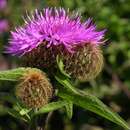Comments
provided by eFloras
According to R. J. Moore (1972), reports of
Centaurea nervosa Willdenow [
C. uniflora Turra subsp.
nervosa (Willdenow) Bonnier & Layens] from New York were based on a specimen referable to
C. phrygia subsp.
phrygia. Moore called these plants
C. austriaca Willdenow, which J. Dostál (1976) treated as a synonym of
C. phrygia subsp.
phrygia.
Specimens of Centaurea phrygia are sometimes misidentified as C. nigrescens (or one or another of its synonyms) or as C. nigra. The elongate, often recurved, setose-ciliate tips of the phyllary appendages are a readily recognizable characteristic of this species. Considerable morphologic variation occurs in vegetative features and head dimensions in American material of the species, and it is possible that one or more of the specimens we have identified as C. phrygia represent an extreme variant of one of the members of the C. jacea complex. J. Dostál (1976) recognized 10 subspecies of C. phrygia in Europe. We have chosen not to assign the sparse North American material to subspecies.
- license
- cc-by-nc-sa-3.0
- copyright
- Missouri Botanical Garden, 4344 Shaw Boulevard, St. Louis, MO, 63110 USA
Description
provided by eFloras
Perennials, 15–80 cm. Stems few–many, erect, simple or branched. Leaves ± arachnoid-tomentose; basal and proximal cauline winged-petiolate, blades lanceolate to ovate, 3–15 cm, margins entire or dentate; distal cauline sessile, sometimes clasping, not decurrent, well developed. Heads usually radiant, usually borne singly. Involucres ovoid to ± spheric, 15–20 mm. Principal phyllaries: bodies lanceolate to ovate, loosely tomentose or glabrous, appendages brown or blackish, lanceolate to ovate, ± covering bodies of adjacent phyllaries, tips often recurved, elongate, featherlike, pectinately dissected into long, filiform lobes. Inner phyllaries: tips erect, ovate or orbiculate, irregularly dentate or lobed. Florets many. the peripheral sterile; corollas pink or purple, those of sterile much expanded and exceeding corollas of fertile florets, those of fertile 20–25 mm. Cypselae tan, 3–4 mm, finely hairy; pappi 0 or of many unequal bristles 0.5–2 mm. 2n = 22 (Russia), 44 (Slovenia).
- license
- cc-by-nc-sa-3.0
- copyright
- Missouri Botanical Garden, 4344 Shaw Boulevard, St. Louis, MO, 63110 USA
Synonym
provided by eFloras
Centaurea austriaca Willdenow
- license
- cc-by-nc-sa-3.0
- copyright
- Missouri Botanical Garden, 4344 Shaw Boulevard, St. Louis, MO, 63110 USA
Centaurea phrygia: Brief Summary
provided by wikipedia EN
Centaurea phrygia, commonly called wig knapweed, is a species of Centaurea. It is native to Europe.
- license
- cc-by-sa-3.0
- copyright
- Wikipedia authors and editors

